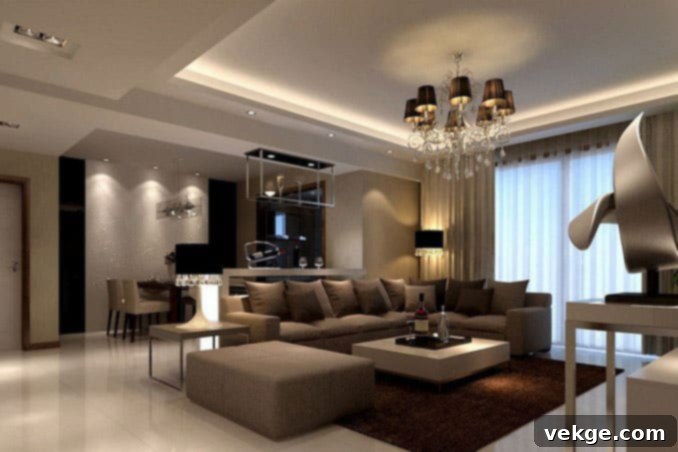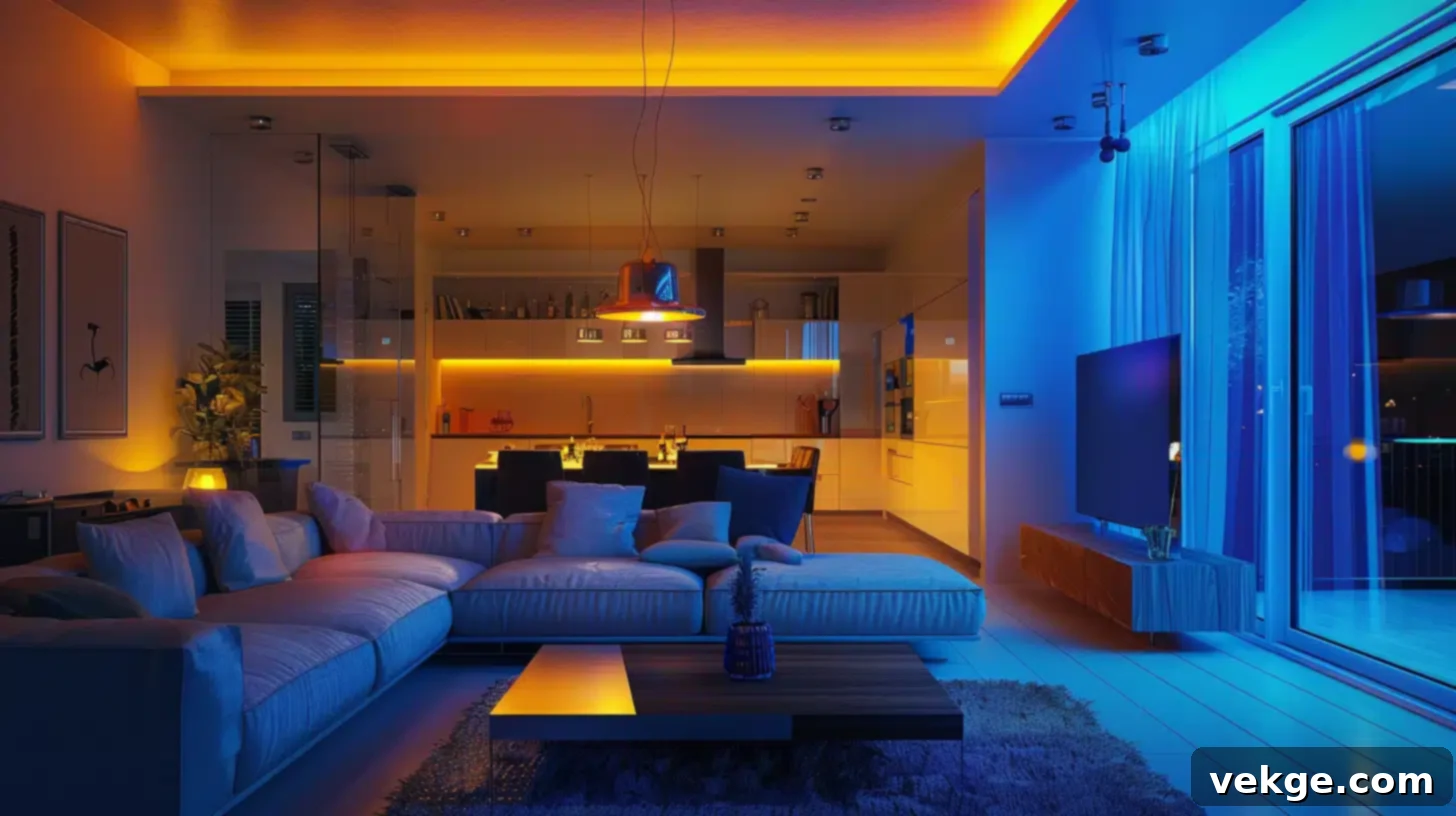Mastering Home Lighting: A Comprehensive Guide to Enhancing Ambiance and Functionality
Lighting is far more than just a source of illumination; it’s a powerful design element that fundamentally shapes the mood, aesthetic appeal, and overall functionality of any home. Thoughtful lighting design has the profound ability to transform spaces, influencing everything from our productivity and comfort to our general well-being. From the vibrant energy required in a bustling kitchen to the serene calm of a reading nook, the right lighting fixtures and strategies can drastically alter a room’s ambiance and define its character.
A home that is strategically well-lit fosters a sense of comfort, supports daily activities, and enhances well-being while significantly reducing eye strain. The market offers a vast array of lighting options, catering to diverse needs, design preferences, and functional requirements. To achieve a harmonious and cohesive look, it’s crucial to consider how each lighting style and fixture integrates with the space’s existing color scheme, furniture arrangement, and unique architectural elements. Selecting the perfect fittings from a wide range ensures that your lighting not only meets practical needs but also significantly elevates your space’s visual appeal.
Understanding the Core Types of Lighting and Their Applications
Effective home lighting relies on a multi-layered approach, typically categorized into three primary types: ambient, task, and accent lighting. Each plays a distinct yet interconnected role in crafting a well-balanced and dynamic lighting plan. When these layers are thoughtfully combined, they create an environment that is both beautiful and highly functional.

- Ambient Lighting: The Foundation of Illumination
Ambient lighting, often referred to as general lighting, is the primary source of illumination in any room. Its main purpose is to provide a consistent, comfortable level of brightness that allows for safe movement and general visibility. It ensures that a room is adequately lit without creating harsh shadows or glare. Common fixtures for ambient lighting include chandeliers, ceiling-mounted fixtures like flush mounts and semi-flush mounts, recessed lighting, and even large floor lamps that diffuse light evenly throughout the space. The goal is to create a soft, welcoming glow that forms the foundational layer upon which other lighting types can build. - Task Lighting: Focused Illumination for Activities
Task lighting is localized and intensely focused, designed to illuminate specific areas where activities such as reading, cooking, working, or grooming are performed. Its primary function is to provide sufficient brightness to prevent eye strain and improve concentration on detailed tasks. The key to effective task lighting is to position the light source directly where it’s needed, ensuring it’s bright enough without being glaring. Examples include under-cabinet lights in a kitchen, desk lamps in a home office, vanity lights in a bathroom, and reading lamps beside a sofa or bed. Proper task lighting is crucial for both productivity and comfort. - Accent Lighting: Highlighting Beauty and Adding Drama
Accent lighting is used to highlight specific objects, architectural features, or areas within a room, adding drama, depth, and visual interest. It draws the eye to focal points such as artworks, sculptures, decorative plants, or textured walls, making them stand out. This type of lighting is often achieved with spotlights, track lighting, recessed lighting with adjustable gimbals, or picture lights, all of which can be precisely directed. Accent lighting adds a layer of sophistication and can transform a simple room into a gallery-like space, emphasizing the elements you wish to showcase. - Decorative Lighting: Enhancing Style and Personality
While often overlapping with accent lighting, decorative lighting serves a distinct purpose: to enhance the aesthetic appeal and personality of a space through the fixture itself. These lights are chosen not just for their illumination but for their artistic value and ability to complement the room’s decor. Chandeliers, decorative pendants, wall sconces with intricate designs, and even string lights or fairy lights fall into this category. They act as jewelry for the room, contributing significantly to the overall style and creating a specific mood, even when they also provide ambient or accent light.
Key Design Principles in Home Lighting
Just as with interior design, effective lighting design adheres to fundamental artistic principles. Understanding how light interacts with space, color, and texture is paramount for creating a harmonious, functional, and inviting environment. When these principles—balance, contrast, emphasis, layering, rhythm, and scale—are applied thoughtfully, every component of the room works together to form a captivating and cohesive whole.

Balance in Lighting Design
A balanced lighting scheme involves the strategic combination and distribution of various lighting types (ambient, task, accent) to create a cohesive and visually comfortable environment. This balance ensures that no single area is over-lit or under-lit, promoting an overall sense of equilibrium and preventing harsh glares or deep shadows. It’s about distributing light sources evenly and appropriately for the room’s function and size, creating a pleasant and functional glow across the entire space.
Creating Contrast with Light
Lighting contrast is achieved by varying light intensities, color temperatures, and directions within a space. This technique enhances visual interest, adds depth, and defines different zones. High-contrast areas, often created by accent lighting, draw immediate attention to focal points, making them stand out dramatically. Conversely, softer, more diffuse lighting in other areas creates a relaxed and intimate atmosphere. Strategic contrast can guide the eye and add dynamic energy to a room.
Emphasis through Illumination
Emphasis in lighting is the deliberate act of highlighting essential elements within a room, ensuring they capture attention. This principle is closely linked to accent lighting, where specific objects like artwork, architectural details, or unique furniture pieces are illuminated to make them prominent. Effective emphasis can transform an ordinary object into a focal point, telling a story or directing the viewer’s gaze to a desired element.
The Art of Layering Light
Perhaps the most crucial principle in modern lighting design is layering. It involves combining ambient, task, and accent lighting to create depth, flexibility, and a nuanced atmosphere. Instead of relying on a single overhead light, layering allows you to adjust the mood and functionality of a room instantly. For example, a living room might use recessed lights for ambient glow, a floor lamp for reading (task), and picture lights to highlight artwork (accent), all controllable independently to suit different activities and times of day. This creates a rich, inviting, and highly adaptable environment.
Rhythm and Scale in Lighting
Rhythm in lighting refers to the repetition or alternation of light and shadow, or the placement of fixtures, creating a sense of movement or pattern. This could be a series of pendant lights over a long island or strategically placed wall sconces down a hallway. Scale, on the other hand, ensures that lighting fixtures are appropriately sized for the space they occupy. An oversized chandelier in a small room can feel overwhelming, while tiny sconces in a grand hall might appear insignificant. Both rhythm and scale contribute to the overall visual harmony and comfort of a room.
Choosing the Right Fixtures for Every Space
Choosing the right light fixtures for a room goes beyond mere aesthetics; it depends on its specific purpose, existing decor style, ceiling height, and the desired mood. Different fixtures, from grand chandeliers to subtle wall sconces, can complement any modern, traditional, industrial, or eclectic aesthetic. The key is to select fixtures that not only enhance the overall architectural motif but also provide adequate and appropriate illumination for the intended function of the room.
Consider the room’s function: a kitchen benefits from bright, shadow-free task lighting, often achieved with recessed lights, under-cabinet lighting, and pendants over an island. A living room thrives on a blend of ambient and accent lighting to create a warm, inviting atmosphere, utilizing floor lamps, table lamps, and picture lights. Bedrooms generally require softer, diffused lighting for relaxation, often incorporating dimmable overhead lights, bedside lamps, and perhaps subtle wall washes. A home office, conversely, demands focused task lighting combined with sufficient ambient light to reduce eye strain during work hours.
Beyond the type of fixture, consider the light source itself. LEDs are now the industry standard due to their energy efficiency, longevity, and versatility. Also, pay attention to the light’s color temperature (measured in Kelvins), which ranges from warm white (2700K-3000K, good for bedrooms and living rooms) to cool white (4000K-5000K, ideal for task-oriented areas like kitchens and offices). The Color Rendering Index (CRI) is another critical factor, indicating how accurately a light source reveals the true colors of objects compared to natural light; a higher CRI (90+) is generally preferred for quality lighting.
Embracing Innovative Lighting Technologies for the Modern Home
Modern lighting technologies are revolutionizing home illumination, offering unprecedented control, efficiency, and customization. These innovations move beyond simple on/off switches, allowing users to fine-tune their environments to an exceptional degree. The integration of smart lighting and adjustable color temperature bulbs stands at the forefront of this evolution.
Smart Lighting Systems: Convenience and Control
Smart lighting allows users to control their lights via smartphone apps, voice commands, or automated schedules. These systems integrate seamlessly with other smart home devices, offering enhanced convenience, security, and energy efficiency. Imagine dimming lights with a voice command, setting scenes for movie night, or having lights automatically turn on when you arrive home. Many systems also offer geofencing, motion detection, and integration with security cameras, adding layers of functionality beyond basic illumination.
Adjustable Color Temperature (Tunable White) LEDs: Tailoring Your Environment
Color-tunable LEDs empower users to adjust the color temperature of their lights, ranging from warm, cozy amber to crisp, bright cool white. This technology significantly enhances comfort and productivity by allowing the lighting to adapt to the time of day or the specific activity. For instance, a warm white light in the evening can promote relaxation and better sleep, while a cooler, brighter light in the morning can boost alertness and concentration. This is particularly beneficial in multi-functional rooms, such as a living room that doubles as a home office, where distinct lighting settings are needed throughout the day.
Energy Efficiency and Sustainability
The widespread adoption of LED technology is a cornerstone of sustainable lighting. LEDs consume significantly less energy than traditional incandescent or fluorescent bulbs, drastically reducing electricity bills and carbon footprints. Furthermore, smart lighting systems often incorporate dimmers and motion sensors, optimizing energy usage by ensuring lights are only on when needed and at the appropriate brightness. This commitment to energy efficiency not only benefits the environment but also provides long-term cost savings for homeowners.
Human-Centric Lighting: Wellness at Its Core
An emerging trend, human-centric lighting (HCL), takes adjustable color temperature a step further. HCL systems are designed to mimic natural daylight patterns, supporting our circadian rhythms and enhancing overall well-being. By automatically shifting color temperature and intensity throughout the day, HCL can improve mood, boost productivity, and regulate sleep cycles, making our indoor environments healthier and more responsive to our biological needs.
Conclusion: Illuminating Your Lifestyle
Effective home lighting is a cornerstone of modern interior design, offering a profound impact on comfort, functionality, and aesthetic appeal. By understanding the different types of lighting – ambient, task, accent, and decorative – and applying fundamental design principles like balance, contrast, emphasis, and layering, homeowners can craft spaces that are both beautiful and highly responsive to their needs. Embracing innovative technologies such as smart lighting and tunable white LEDs further empowers us to personalize our environments, enhance our well-being, and contribute to a more sustainable future. Investing in thoughtful lighting design is not merely about brightening a room; it’s about illuminating a lifestyle.
Resources
https://www.visualcomfort.com/
